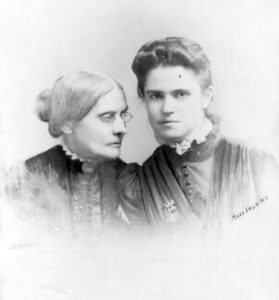The 19th Amendment and Equal Rights for Women
There was a time when women couldn’t vote. The 19th Amendment fixed that.
By: Sarah Cowgill | August 17, 2020 | 489 Words

Alice Paul and other women celebrating (Photo by Universal History ArchiveUIG via Getty images)
“Everybody counts in applying democracy. And there will never be a true democracy until every responsible and law-abiding adult in it, without regard to race, sex, color or creed has his or her own inalienable and unpurchaseable voice in government.” These were the words of Carrie Chapman Catt in a speech at the 1917 symposium Votes for All.
Democracy involves making decisions by letting people get together and vote on what should be done. But women didn’t always have the right to vote in the United States. Three years later, Catt would achieve a lifelong dream – winning the right to vote for women.
America is celebrating the 100th anniversary of the passage of the 19th Amendment to the U.S. Constitution, which guarantees, “The right of citizens of the United States to vote shall not be denied or abridged by the United States or by any State on account of sex.”
After nearly 100 years of petitioning the US government, women were finally granted the right to vote in 1920 under the presidency of Woodrow Wilson.
The Suffragettes
Female activists called suffragettes loosely formed voting rights groups as early as the 1820s. Most groups were local and didn’t gain national momentum until Elizabeth Cady Stanton, Susan B. Anthony, and Lucretia Mott teamed up in 1848 and hosted the Women’s Rights Convention in Seneca Falls, NY. The event pushed the idea of women voting into the national spotlight. The struggle would last another 60 years, finally ending with the 19th Amendment.

Suffragist Susan Anthony and Rachel Foster Avery (Photo by: Universal History Archive/UIG via Getty images)
Suffragette Carrie Chapman Catt campaigned loudly while leading an army of voteless women in 1919 to pressure Congress. In May 1919, Representative James R. Mann (R-IL), chairman of the Suffrage Committee in Congress, proposed a resolution in the House of Representatives to approve the Susan B. Anthony Amendment. The aim was to prevent the federal government from denying the right to vote based on gender. The resolution passed the House of Representatives, 304 to 89.
Two weeks later, on June 4, 1919, the Senate also passed the amendment by 56 votes to 25. It was then sent to the states for ratification, and eventually became the 19th Amendment to the U.S. Constitution. The decision finally hinged on the vote of one young Republican, Representative Harry T. Burn from Tennessee. Or maybe it hinged on his mother, who wrote to him saying, “Don’t forget to be a good boy and help Mrs. Catt put the ‘rat’ in ratification.”
Harry listened to his mother and cast the deciding “yea” vote.
100 Years and Counting
Women went to jail in the early 1900s for the crime of asking for the right to vote. But a lot of things have become more fair over the years. We solve our problems in the government by voting; suffragettes and their allies forever changed this nation by expanding democracy.
















